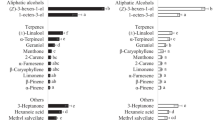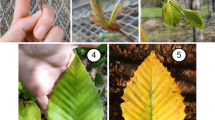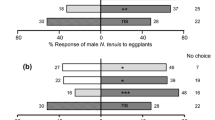Abstract
Hypochlora alba is a specialist grasshopper that lives and feeds almost exclusively onArtemisia ludoviciana, a plant that produces large amounts of allelochemics including a variety of monoterpenes. This plant is not a host for generalist grasshoppers such asMelanoplus sanguinipes. The role of olfaction in the grasshopper-plant relationship was investigated by comparing electroantennograms (EAGs) of males and females of both species generated by solvent-extracted volatiles from plant leaves and by major individual components. Volatiles ofA. ludoviciana were identified by gas chromatography-mass spectrometry. The major components were 1,8-cineole, camphor, camphene, and borneol, while minor identified compounds were α- and β-pinene, α-thujene, myrcene,p-cymene, Artemisia ketone, α-thujone, and bornyl acetate. The EAGs (mV) ofH. alba males to a range of concentrations of individual volatiles or the total plant extract were nearly double those of conspecific females or both sexes ofM. sanguinipes. However, both sexes ofM. sanguinipes were more sensitive than either sex ofH, alba to geraniol, a monoterpene that commonly occurs in many plant species but is absent or is present in only trace amounts inA. ludoviciana. The increased sensitivity ofH. alba males to the odor components of their host plant appears to be related to the greater number of certain olfactory chemoreceptors on male versus female antennae. The significance of this phenomenon is discussed.
Similar content being viewed by others
References
Ahmad, S. (ed.). 1983. Herbivorous Insects: Host-seeking Behavior and Mechanisms. Academic Press, New York, xvi + 257 pp.
Bland, R.G. 1982. Morphology and distribution of sensilla on the antennae and mouthparts ofHypochlora alba (Orthoptera: Acrididae).Ann. Entomol. Soc. Am. 75(3):272–283.
Chapman, R.F. 1982. Chemoreception: The significance of receptor numbers.Adv. Insect Physiol. 6:247–355.
Den Otter, C.J., Schuil, H.A., andSander-Van Ooster, A. 1978. Reception of host-plant odours and female sex pheromone inAdoxophys orana (Lepidoptera: Tortricidae): Electrophysiology and morphology.Entomol. Exp. Appl. 24:370–378.
Dickens, J.C. 1984. Olfaction in the boll weevil,Anthonomus grandis Boh. (Coleoptera: Curculionidae): Electroantennogram studies.J. Chem. Ecol. 10:1759–1785.
Dickens, J.C., andBoldt, P.E. 1985. Electroantennogram responses ofTrihabda bacharides (Weber) (Coleoptera: Chrysomelidae) to plant volatiles.J. Chem. Ecol. 6:767–779.
Guerin, P.M., andVisser, J.G. 1980. Electroantennogram responses of the carrot fly,Psila rosae, to volatile plant components.Physiol. Entomol. 5:111–119.
Guerin, P.M. Staedler, E., andBuser, H.R. 1983. Identification of host-plant attractants for the carrot fly,Psila rosae.J. Chem. Ecol. 9:843–861.
Knutson, H. 1982. Development and survival of the monophagous grasshopperHypochlora alba (Dodge) and the polyphagousMelanoplus bivittatus (Say) andMelanoplus sanguinipes (F.) on Louisiana sagewort,Artemisia ludoviciana Nutt.Environ. Entomol. 11:777–782.
Kozlowski, M.W., andVisser, J.H. 1981. Host plant related properties of the antennal olfactory system in the oak flea weevil,Rhynchaenus quercus. Electroantennogram study.Entomol. Exp. Appl. 30:169–175.
Loomis, W.D., andCroteau, R. 1980. Biochemistry of terpenoids, pp. 363–418,in P.K. Stumpf and E.E. Conn (eds.). The Biochemistry of Plants, Vol. 4. Academic Press, New York.
Ma, W.-C., andVisser, J.H. 1978. Single unit analysis of odor quality coding by the olfactory antennal receptor system of the Colorado beetle.Entomol. Exp. Appl. 24:520–533.
May, M.L., andAhmad, S. 1983. Host location in the Colorado potato beetle: Searching mechanisms in relation to oligophagy, pp. 173–199,in S. Ahmad (ed.). Herbivorous Insects: Hostseeking Behavior and Mechanisms. Academic Press, New York, xvi + 257 pp.
McCauley, D.E., Ott, J.R., Stine, A., andMcGrath, S. 1981. Limited dispersal and its effect on population structure in the milkweed beetleTetraopes tetraophthalmus.Oecologia 51:145–150.
Mulkern, G.B.,Pruess, K.P.,Knutson, H.,Hagen, A.F.,Campbell, J.B., andLambley, J.D. 1969. Food habits and preferences of grassland grasshoppers of the north central Great Plains.N.D. Agric. Exp. Stn. Bull. 481:32pp.
Mustaparta, H. 1975. Responses of single olfactory cells in the pine weevilHylobius abietis L. (Col: Curculionidae).J. Comp. Physiol. 97:271–290.
Mustaparta, H. 1984. Olfaction, pp. 37–70,in W.J. Bell and R.T. Cardé (eds.). Chemical Ecology of Insects. Sinauer Associates, Sunderland, Massachusetts.
Oakley, B., andSchafer, R. 1978. Experimental Neurobiology: A Laboratory Manual. University of Michigan Press. Ann Arbor, xii + 367 pp.
Schneider, D. 1957. Elektrophysiologische Untersuchungen von Chemo- und Mechanorezeptoren der Antenne des SeidenspinnersBombyx mori L.Z. Vergl. Physiol. 40:8–41.
Smith, S.G.F., andGrodowitz, G.U. 1983. Effects of nonglandular trichomes ofArtemisia ludoviciana Nutt. (Asteraceae) on ingestion, assimilation, and growth of the grasshoppersHypochlora alba (Dodge) andMelanoplus sanguinipes (F.) (Orthoptera: Acrididae).Environ. Entomol. 12:1766–1772.
Smith, S.G.F., andKreitner, G.L. 1983. Trichomes inArtemisia ludoviciana Nutt. (Asteraceae) and their ingestion byHypochlora alba (Dodge) (Orthoptera: Acrididae).Am. Midl. Nat. 110:118–123.
Stangl, R., andGreger, H. 1980. Monoterpenes and systematics of the genusArtemisia (Asteraceae. Anthemideae).Plant Syst. Evol. 136:125–136.
Visser, J.H. 1979. Electroantennogram responses of the Colorado beetle,Leptinotarsa decemlineata to plant volatiles.Entomol. Exp. Appl. 25:86–97.
Visser, J.H. 1983. Differential sensory perceptions of plant compounds by insects, pp. 215–230,in P.A. Hedin (ed.). Plant Resistance to Insects. American Chemical Society Symposium Series 208, American Chemical Society, Washington, D.C.
Visser, J.H. 1986. Host odor perception in phytophagous insects.Annu. Rev. Entomol. 31:121–144.
Yan, F., andVisser, J.H. 1982, Electrantennogram response of the cereal aphidSitobion avenae to plant volatile components, pp. 387–388,in J.H. Visser and A.K. Minks (eds.). Proceedings of the 5th International Symposium on Insect-Plant Relationships, 1982. Pudoc, Wageningen.
Author information
Authors and Affiliations
Rights and permissions
About this article
Cite this article
Blust, M.H., Hopkins, T.L. Olfactory responses of a specialist and a generalist grasshopper to volatiles ofArtemisia ludoviciana nutt. (Asteraceae). J Chem Ecol 13, 1893–1902 (1987). https://doi.org/10.1007/BF01013238
Received:
Accepted:
Issue Date:
DOI: https://doi.org/10.1007/BF01013238




